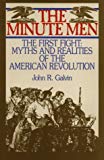Samuel Adams and John Hancock: A Common Alliance between Two Uncommon Heroes
It may strike Americans that the end of the 20th century holds a unique place in history. Filled with the pursuit of social justice amidst class struggles, Americans today feel we are far removed from our founding fathers. However, most would be surprised to discover how two different classes of people joined together when pressed by a common enemy. These first Americans are an early example that many today would have difficulty emulating. The alliance between Samuel Adams and John Hancock exemplifies these bonds clearly.
By most standards, Samuel Adams and John Hancock held little in common. Yet, on the late evening of April 18, 1775, these two opposites found themselves hiding together (Fischer, 94) in Reverend Jonas Clarke’s home being warned by Paul Revere that hundreds of British troops were searching for them, and them only, to arrest them for treason. How could two men from such different backgrounds, fifteen years apart in age, be such a threat to the crown of England? Adams and Hancock were hardly the stereotypical Bostonians of their day. Like many Americans today, they differed in their upbringing, their financial status, and in their associated groups.
Although both Adams and Hancock had clergymen for fathers and went to Harvard, they had little common in their childhood. In 1722, Adams was born a seventh generation American and schooled in the classics, including Latin. He was one of twelve children, nine of whom died before his parents did. His father, a clergyman, died broke, and Samuel himself failed at several businesses, including the brewery business that is still named for him today. In addition, Adams suffered from a “perpetual tremor, sometimes so severe he could hardly write” (Langguth, 90). Hancock’s business skills, and his own reputed skills as a smuggler, began to form early. Hancock’s father died when he was seven, and their rich uncle, who acquired his wealth largely by smuggling, raised John and his two siblings. In a trip to London, Hancock witnessed the coronation ceremonies of King George III, and was “dazzled” (Langguth, 89).
Adams and Hancock differed greatly in their financial status. At the age of 28, Hancock inherited his uncle’s estate, estimated at seventy thousand pounds (Langguth, 90). He was New England’s richest man, and Boston’s most eligible bachelor. He frequently held balls and parties, and rode everywhere in a carriage. He owned many ships, the seizing of one by the crown that would later stir his blood. Before long, his own estate and business dealings would cause him to listen keenly to Samuel Adams. Adams was consistently poor throughout his life. In desperation, he once accepted a job as tax collector despite his own personal beliefs. He was known for the frumpy clothes he wore, and many believed that he only owned one suit. When elected to represent Boston in the first continental congress at Philadelphia, he was anonymously given a trunk with a “complete suit of clothes, two pairs of shoes of the best style, a set of silver shoe-buckles, a set of gold knee-buckles, a set of gold sleeve-buttons, an elegant cocked hat, a gold-headed cane, a red cloak, and number of minor articles” (Fowler, 131). These were items that any upper-class citizen would already own. The likely gift-giver was John Hancock.
Hancock’s impact extended largely to men of influence like himself. He was a merchant, ship-owner, and a man that every eye watched, whether friend or foe. That he fell in line with radicals like Samuel Adams only served to further influence other Bostonians who looked up to him as an example, and to those few who were his equals. Samuel Adams did not gain automatic recognition like Hancock. He worked tirelessly for it. He won over small groups, one at a time. His powerful rhetoric and puritan reasoning eventually placed him in leadership in a half-dozen diverse groups, consisting largely of tradesmen. His most famous group, the Sons of Liberty, could put hundreds, sometimes thousands, of commoners in the streets at a moment’s notice, leading parades, tarring and featherings, and even the burning of homes. That Samuel Adams led this motley group, yet had strong, influential ties to a man of John Hancock’s standing, is evidence again of the break in ordinary social norms of the day.
Lest anyone think these differences were entirely class-oriented, it should also be noted that Hancock and Adam’s personalities clashed. At times, Hancock found Adams “contentious, uncompromising, and overbearing” (Fowler, 115). They often disagreed on issues and viewed events in differing lights. But these two men had at in their hearts the sense of justice and perseverance that made them stand together. If two men as diverse as Adams and Hancock can affect the ire of the world’s most powerful country and help lead their citizens to a safety and peace the world had not known since Rome, imagine what Americans today could accomplish if they break down the walls that separate them.
Works Consulted

 Fischer, David Hackett. Paul Revere’s Ride. New York: Oxford UP, 1994.
Fischer, David Hackett. Paul Revere’s Ride. New York: Oxford UP, 1994.
Fowler, Jr., William F. Samuel Adams: Radical Puritan. New York: Addison-Wesley Longman, 1997.
Galvin, John R. The Minute Men: The First Fight - Myths and Realities of the American Revolution. Brassey’s: Washington, 1989.
Langguth, A.J. Patriots: The Men Who Started the American Revolution. New York: Simon & Schuster, 1988.





RSS feed for comments on this post. | TrackBack URI
